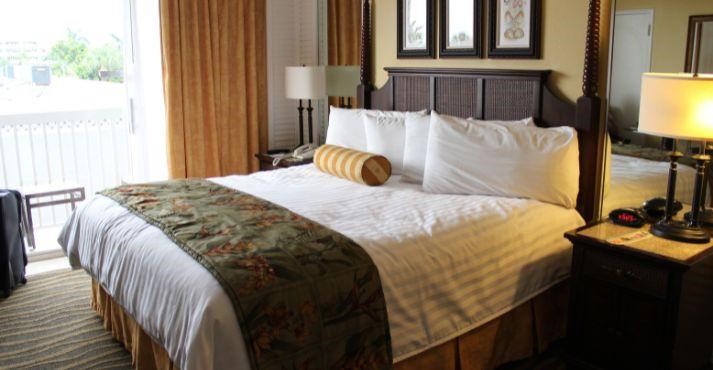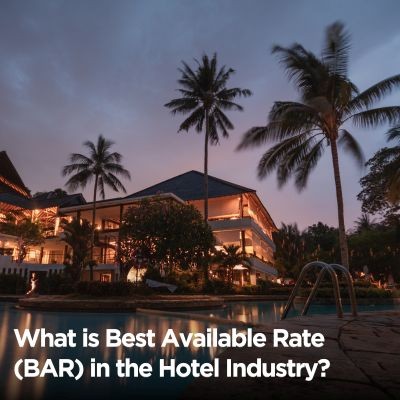Understanding the Average Daily Rate (ADR) is crucial for Singapore’s hoteliers, investors, and industry professionals. ADR is a crucial metric that sheds light on the average price paid for rooms sold within a given timeframe.
In a competitive market like Singapore’s thriving hospitality industry, comprehending ADR enables stakeholders to make informed decisions regarding pricing strategies, revenue optimization, and investment opportunities.
Understanding the distinctions of ADR can help hoteliers fine-tune their pricing strategies to maximize profitability, while investors can assess the financial performance and potential returns of hospitality assets.
Industry professionals rely on ADR data to gauge market trends, benchmark performance, and formulate strategic plans for sustainable growth. Understanding the average daily rate allows stakeholders to steer Singapore’s hospitality domain with confidence and foresight. Understanding the importance of Average Daily Rate (ADR) is like having a compass guiding you through the financial landscape of a hotel. Let’s delve into why ADR is a pivotal factor in hospitality management.
What is Average Daily Rate (ADR)?

The Average Daily Rate (ADR) is a decisive measure in the hotel industry that helps understand how much money a hotel makes, on average, from each room it sells in a day.
To calculate ADR, we divide the total revenue generated from selling rooms by the number of rooms sold during a specific time, usually a day.
Let’s break it down: Imagine a hotel sold 50 rooms daily and made $5,000 from those room sales. To find the ADR, we would divide $5,000 by 50, giving us an ADR of $100. On average, each room brought in $100 in revenue for that day.
The components of ADR include room revenue, which is the money earned from selling rooms, and the total number of rooms sold.
By looking at ADR, hotel owners and managers can understand how well their hotel performs financially.
It helps them see if they’re charging the correct room prices and selling enough to make a good profit. In simple terms, ADR is like checking how much money a lemonade stand makes from each cup of lemonade it sells.
How to Calculate ADR?
To begin, ADR involves two leading players – room revenue and the number of rooms sold. Consider room revenue as the earnings from renting out rooms and rooms sold as the number of rooms booked.
Now, let’s dive into the formula:
ADR = Total Room Revenue 
Here, we divide the total room revenue by the number of rooms sold. It’s like finding out how much money, on average, each room contributes to the total revenue.
Example 1: Small Boutique Hotel

- Total Room Revenue: $15,000
- Rooms Sold: 50
ADR= $15,000 
For this boutique hotel, the ADR is $300, showing the average earnings per room.
Example 2: Large Chain Hotel
Total Room Revenue: $100,000
Rooms Sold: 200
ADR = $100,000 
In the case of the large chain hotel, the ADR is $500, reflecting a higher average earnings per room.
Step-by-Step Guide to Using ADR
1. Collect Data:
Start by gathering information on total room revenue and the number of rooms sold during a specific period.
2. Apply the Formula:
Plug in the numbers into the ADR formula:
ADR= Total Room Revenue 
3. Calculate:
Perform the calculation to find the ADR, representing the average earnings for each room.
Following these steps, hoteliers and financial analysts can easily calculate ADR, showing their average room revenue. Understanding and applying the formula in real-world scenarios is critical to maximizing ADR and overall financial success.
Importance of ADR in the Hotel Industry

Average Daily Rate (ADR) plays a fundamental role in the hotel industry by helping hotels manage their revenue effectively. Here’s why ADR is necessary:
- Optimizing Pricing Strategies: ADR helps hotels set the correct room prices. By analyzing ADR data, hotels can understand the demand for rooms during different times of the year or days of the week. This enables them to adjust their pricing strategies accordingly, offering competitive rates during high-demand periods and attractive deals during off-peak times to attract more guests.
- Maximizing Revenue: A higher ADR means more revenue for the hotel. By strategically pricing their rooms based on ADR insights, hotels can maximize their earnings. This revenue can then be reinvested into the hotel to improve facilities, services, and overall guest experience, further increasing profitability in the long run.
- Impact on Profitability: A higher ADR directly contributes to increased hotel profitability. When hotels can charge more for their rooms without compromising occupancy rates, they can achieve higher profit margins, which is essential for the financial health and sustainability of the business.
- Market Positioning: A strong ADR helps hotels maintain a competitive edge. Hotels with higher ADRs are perceived as offering better quality and value, allowing them to position themselves as premium establishments and attract more discerning guests.
Factors that Affect Hotel’s ADR
Understanding the factors influencing a hotel’s Average Daily Rate (ADR) is crucial for hoteliers to optimize pricing strategies and maximize revenue.
Several vital factors impact ADR, ranging from market demand and seasonality to local laws and competition.
Let’s look into these factors to understand how they shape ADR in the hospitality industry.
1. Seasonality
Seasonality plays a significant role in determining a hotel’s Average Daily Rate (ADR). During peak tourist seasons, like summer or holidays, demand for hotel rooms tends to surge as travelers flock to popular destinations for vacations or special events.
As a result, hotels often capitalize on this high demand by increasing their room rates, leading to higher ADRs.
On the contrary, during off-peak periods, such as the winter season or weekdays, demand for accommodation decreases, causing hotels to lower their room rates to attract guests. Consequently, ADRs during these times are typically lower compared to peak seasons.
For example, a beach resort might experience higher ADRs when tourists seek sun and sand during summer, while ski resorts may see higher rates during winter.
Understanding these seasonal fluctuations allows hoteliers to adjust their pricing strategies, maximizing revenue during peak periods and maintaining competitiveness during off-peak times.
2. Demand Trends
Demand trends are pivotal in shaping the Average Daily Rate (ADR) in the hotel industry, especially in dynamic markets like Singapore. According to a report by Meeting and Conventions-Asia, significant events and festivals, such as the Singapore Grand Prix, contribute to a significant surge in hotel occupancy rates, with ADRs often rising by up to 27% during these periods.
Additionally, data from the Singapore Tourism Board, published by Coherent Market Insights, reveals that international conferences and exhibitions in Singapore attract many business travelers, leading to spikes in demand and ADRs, particularly for hotels near convention centers or event venues.
Conversely, economic downturns or global crises can dampen travel demand, resulting in lower occupancy rates and ADRs. During the 2008 financial crisis, for instance, the Economic Survey of Singapore reported that hotel ADRs in Singapore declined 14%.
Furthermore, fluctuations in currency exchange rates, such as the depreciation of the Singapore dollar, have been shown to impact consumer spending behaviors and hotel pricing strategies, influencing ADR trends accordingly.
3. Competition

Competition significantly shapes the Average Daily Rate (ADR) in the hotel industry, particularly in Singapore. Hotels continuously monitor their competitors’ pricing strategies and adjust their rates to maintain competitiveness and market positioning.
In Singapore’s hospitality sector, where numerous hotels vie for travelers’ attention, pricing decisions are often influenced by the prevailing market dynamics and competitor actions.
Hotels may use competitive pricing strategies, such as price matching or undercutting, to attract guests and capture market share.
On the other hand, luxury hotels may maintain higher ADRs to uphold their premium positioning and differentiate themselves from mid-range or budget accommodations.
Market dynamics, including changes in supply and demand, also impact ADRs as hotels strive to balance maximizing revenue and maintaining occupancy levels.
During periods of high demand, hotels may capitalize on the opportunity to increase ADRs. In contrast, in times of low demand, they may offer promotional rates or discounts to stimulate bookings and fill rooms.
4. Economic Conditions
Economic conditions are pivotal in shaping the Average Daily Rate (ADR) in Singapore’s hotel industry. According to data from the Department of Statistics Singapore published by HVS, fluctuations in GDP growth directly correlate with changes in hotel occupancy rates and ADRs.
During periods of robust GDP growth exceeding 3%, hotel ADRs have been observed to increase by an average of 10% year-on-year. Conversely, during economic downturns such as the 2008 financial crisis, a 20% decline in ADRs, coinciding with a contraction in GDP by 4.2%, was reported.
Furthermore, currency exchange rates also impact ADR trends. According to a study by the Monetary Authority of Singapore and published by HVS, a 3% depreciation in the Singapore dollar against major currencies like the US dollar typically results in an approx 12% increase in foreign tourist arrivals and a subsequent rise in ADRs by 8-10%.
Consumer spending patterns are another critical factor influencing ADRs.Research reveals that during periods of high consumer confidence, characterized by increased retail sales and leisure expenditure, hotel ADRs tend to rise by 12-15%.
On the downside, travelers may exercise greater caution during economic uncertainty and tighten their discretionary spending, resulting in subdued demand for hotel rooms. To stimulate demand and maintain occupancy levels, hotels may implement pricing strategies that reduce ADRs or offer promotional deals and discounts to attract budget-conscious travelers.
5. Events and Festivals
Events, festivals, and conventions significantly influence the Average Daily Rate (ADR) in Singapore’s hotel industry, presenting opportunities for hotels to optimize revenue generation.
Significant events such as international conferences, music festivals, and cultural celebrations attract a surge of visitors to the city-state, leading to heightened demand for accommodations.
In response to increased demand during these peak periods, hotels strategically adjust their rates to capitalize on the influx of travelers.
During popular events like the Singapore International Film Festival, hotels experience a surge in bookings as attendees seek lodging options near event venues.
Recognizing the heightened demand, hotels often implement dynamic pricing strategies, elevating ADRs to reflect the increased value of their rooms.
Additionally, hotels may offer package deals or special promotions targeting event attendees, further boosting revenue opportunities.
Conversely, hotels may adjust ADRs downwards to attract guests and maintain occupancy levels during low demand when no significant events are scheduled.
6. Local Regulations
In Singapore, hotels must adhere to various regulations and taxes that can affect the Average Daily Rate (ADR) and overall revenue. Two significant regulations impacting ADR include:
- Goods and Services Tax (GST): Hotels in Singapore must charge a 9% GST on accommodations. This tax is added to the room rate and influences guests’ final ADR.
- Tourism Levy: The Singapore government imposes a tourism levy on visitors staying at licensed accommodations, including hotels. This levy contributes to the country’s tourism development efforts and may impact hotel pricing strategies, thus influencing ADR.
Furthermore, the government periodically reviews and adjusts tourism-related policies and regulations, which can indirectly impact ADRs. Compliance with local regulations and tax requirements is essential for hotels to operate legally and maintain financial stability.
For instance, changes in visa regulations, tourism promotion initiatives, or the introduction of new attractions may influence visitor arrivals and subsequently affect demand for hotel rooms, thereby influencing ADR trends.
Strategies for Increasing ADR
Now let us look at the different strategies that a hotel can deploy to increase their average daily rate (ADR) and drive more sales :
1. Dynamic Pricing
Implementing dynamic pricing strategies, such as yield and revenue management systems, is crucial in Singapore’s hospitality industry. These strategies help hotels adjust room rates based on changes in demand and market conditions.
For instance, hotels can increase room rates during peak seasons or high-demand periods to capitalize on the increased demand from tourists and business travelers. Conversely, hotels may offer discounts or promotions to attract guests during off-peak times when demand is lower.
2. Upselling Room Upgrades

Offering room upgrades to guests presents an excellent opportunity for hotels to increase their Average Daily Rate (ADR) and the overall guest experience.
Hotels can entice guests to opt for higher-tier accommodations by highlighting the benefits of upgraded rooms, such as additional space, better views, or enhanced amenities.
Upselling room upgrades increase revenue per guest and improve customer satisfaction by providing a more luxurious and comfortable stay.
Additionally, guests who opt for room upgrades may be more inclined to spend on other hotel services, such as dining or spa treatments, contributing to ancillary revenue.
Overall, upselling room upgrades is a win-win strategy for hotels. It boosts ADR while enhancing the guest experience, increasing loyalty and positive word-of-mouth recommendations.
3. Packages and Promotions
Hotels often use packages and promotions to attract guests and boost their Average Daily Rate (ADR). These deals usually bundle various services or perks, like complimentary breakfast, spa treatments, or tickets to local attractions, creating an attractive offer for guests.
By providing these bundled deals, hotels not only persuade guests to book but also increase the overall value of their stay. Additionally, offering exclusive promotions for direct bookings can help hotels reduce reliance on third-party booking platforms and increase their profit margins.
These strategies attract more guests and encourage them to spend more during their stay, ultimately leading to higher ADR and increased revenue for the hotel.
4. Targeting High-Value Segments
Targeting high-value market segments, like corporate travelers or luxury guests, is a crucial strategy for hotels to increase their Average Daily Rate (ADR).
By understanding these segments’ preferences and needs, hotels can tailor their pricing and packages to offer added value and attract these lucrative guests.
For example, offering exclusive amenities or personalized services that cater to the needs of corporate travelers can justify higher room rates and boost ADR. Similarly, creating luxury packages with premium amenities or experiences can attract high-spending guests seeking a lavish stay.
Additionally, targeting group bookings for events or conferences can lead to bulk reservations and higher ADR, especially when offering customized packages or discounts.
5. Value-Added Services
Providing value-added services and amenities is crucial for hotels to justify higher room rates and increase their Average Daily Rate (ADR).
By offering complimentary breakfast, free Wi-Fi, access to exclusive facilities, or personalized concierge services, hotels can enhance the guest experience and differentiate themselves from competitors.
These added benefits create a perception of value for guests, making them more willing to pay higher prices for their stay.
For example, including complimentary breakfast or free Wi-Fi eliminates additional costs for guests and enhances convenience, making the stay more appealing.
Similarly, access to exclusive facilities like a gym, spa, or pool can elevate the guest experience and justify premium pricing. Personalized concierge services cater to guests’ needs and preferences, creating a sense of luxury and exclusivity.
6. Revenue Management Tactics

Hotels must implement revenue management tactics to optimize their Average Daily Rate (ADR) and maximize revenue. These tactics include length-of-stay restrictions, minimum length-of-stay requirements, and overbooking strategies.
- Length-of-stay restrictions limit the number of consecutive nights a guest can book. By strategically implementing these restrictions, hotels can encourage guests to book shorter stays during high-demand periods, allowing them to accommodate more guests and increase ADR.
- Minimum length of stay requirements dictates the minimum number of nights guests must book to secure a reservation. This tactic helps hotels capitalize on peak periods by ensuring guests stay longer, maximizing occupancy and ADR.
- Overbooking strategies involve accepting more reservations than the hotel’s capacity and anticipating cancellations and no-shows. While risky, this tactic allows hotels to maximize occupancy and revenue, especially during periods of high demand.
7. Strategic Partnerships
Strategic partnerships with local businesses, attractions, or event organizers can significantly boost a hotel’s Average Daily Rate (ADR) and overall revenue.
Hotels can create attractive packages and promotions tailored to specific target markets by collaborating with these entities, driving ADR growth.
These partnerships offer several benefits, including access to new customer segments and increased brand visibility through joint marketing efforts.
For example, a hotel might partner with a popular local restaurant to offer a dinner-and-stay package, inviting food enthusiasts to book a room and dine there.
Similarly, collaborating with event organizers, such as those hosting food and beverage festivals, allows hotels to create special accommodation packages that include tickets to the event.
This attracts attendees looking for convenient lodging options and helps hotels capitalize on the increased demand generated by the event.
Overall, strategic partnerships enable hotels to develop their value proposition, differentiate themselves from competitors, and attract guests willing to pay higher rates for unique experiences.
ADR vs. Other Hospitality Metrics
In the detailed world of hospitality metrics, it’s essential to grasp the details of metrics like ADR (Average Daily Rate), RevPAR (Revenue Per Available Room), and TRevPAR (Total Revenue Per Available Room).
Let’s take a closer look at how ADR relates to these metrics and how it gives us valuable insights into how healthy pricing is working.
1. ADR vs. RevPAR
ADR represents the average revenue earned daily for each room occupied, directly reflecting the effectiveness of the pricing strategy. It is calculated by dividing the total room revenue by the number of rooms sold.
On the other hand, RevPAR (Revenue Per Available Room) evaluates the overall revenue generated per available room, considering both occupied and unoccupied rooms. It is a broader metric that encompasses the impact of occupancy rates on revenue.
Pricing Effectiveness Analysis
When comparing ADR and RevPAR, ADR gives a more focused view of how pricing strategies influence revenue generation for occupied rooms. It is beneficial for assessing the direct impact of pricing decisions on room revenue.
Example: A hotel with a high ADR but lower occupancy may indicate a niche market or a focus on premium services. Conversely, a lower ADR with consistently high occupancy might signal a strategy targeting a broader audience.
2. ADR vs. TRevPAR
TRevPAR (Total Revenue Per Available Room) goes beyond room revenue, considering all revenue streams within the property. It provides a holistic view by including income from additional services like dining, spa, and other amenities.
Pricing Effectiveness Analysis
While ADR focuses on room revenue, TRevPAR evaluates the overall revenue effectiveness, considering the diverse income sources within the hotel.
ADR’s role in this comparison is pivotal as it isolates room revenue performance, helping pinpoint pricing strategies’ impact on accommodation-specific income.
Example: If ADR is high, but TRevPAR is not meeting expectations, it may suggest that pricing strategies for additional services need reassessment. Conversely, a well-balanced increase in ADR and TRevPAR indicates a comprehensive and effective pricing strategy.
What is ADR – FAQs
How is ADR different from APR?
ADR (Average Daily Rate) represents the average revenue earned per room sold in a given period. In contrast, APR (Average Published Rate) averages the range of published room rates for different room types over time.
ADR reflects actual room revenue, whereas APR is based on advertised rates and may not necessarily reflect actual revenue generated.
Do hotel prices change daily?
Hotel prices change daily due to demand fluctuations, seasonality, and events. Revenue management systems allow hotels to adjust room rates based on market conditions and demand trends, ensuring pricing aligns with revenue strategies.
As a result, guests may find varying prices for the same room depending on when they book it.
Conclusion
Wrapping up our exploration of ADR, let’s highlight the key takeaways. Average Daily Rate isn’t just a number; it’s a cornerstone metric in hospitality revenue management.
It plays a crucial role in setting prices, optimizing revenue, and ultimately, staying competitive in the ever-changing hotel industry.
As we conclude our insights into ADR, it’s clear that this metric isn’t just a snapshot of the present; it’s a guide for the future.
With ongoing advancements in revenue analysis, ADR remains at the forefront, shaping the landscape of effective revenue optimization in the hospitality sector.
In the journey ahead, ADR will remain a key player, influencing how hotels navigate the complex world of revenue metrics. So, remember, when it comes to staying competitive and financially savvy in the hotel business, ADR is the compass guiding intelligent decision-making.













